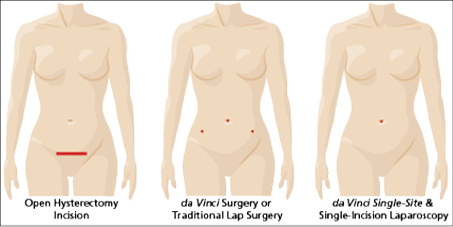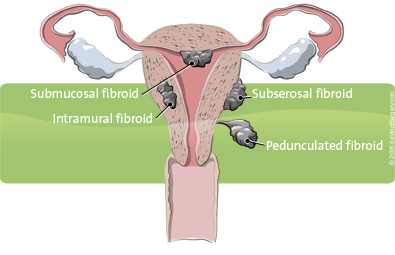Hysterectomy Options
Hysterectomy is the surgical removal of the uterus and, if needed, surrounding organs and tissues. Hysterectomy may be recommended for women with fibroid tumors who don’t plan to become pregnant in the future. Each year in the U.S. alone, doctors perform approximately 600,000 hysterectomies, making it the second most common surgical procedure for women.1
Approaches to Hysterectomy
Open Hysterectomy
During an abdominal hysterectomy (open surgery), your uterus is removed through a large open incision. The incision must be large enough for your surgeon to see your organs and fit his/her hands and instruments inside your body.
Minimally Invasive Hysterectomy Options

Vaginal Hysterectomy – A vaginal hysterectomy is done through a cut in your vagina. The surgeon operates through this incision and closes it with stitches once the uterus is removed.
Traditional Laparoscopy – With traditional laparoscopy, your surgeon operates through a few small incisions in your abdomen using long instruments and a tiny camera. The camera sends images to a monitor in the operating room to guide doctors as they operate.
– Your uterus can also be removed through a small incision in your belly button using da Vinci Single-Site Surgery. This technology allows for virtually scarless results. da Vinci Single-Site is performed for benign (non-cancerous) conditions.
da Vinci Multi-port Hysterectomy – With the da Vinci Surgical System, your doctor operates through a few small incisions (multi-port surgery) – similar to traditional laparoscopy. The da Vinci System features wristed instruments that bend and rotate far greater than the human wrist. The da Vinci System also features a magnified 3D high-definition vision system that allows surgeons to see key anatomy with depth and clarity. As a result, da Vinci enables your surgeon to operate with enhanced vision, precision, dexterity, and control.
da Vinci is a minimally invasive approach that uses the latest in surgical and robotics technologies. Your surgeon is 100% in control of the da Vinci System, which translates his or her hand movements into smaller, more precise movements of tiny instruments inside your body.
da Vinci Hysterectomy is the #1 minimally invasive hysterectomy performed in the U.S.2
Types of Hysterectomy
There are many types of hysterectomy performed, depending on your diagnosis and overall health. All hysterectomies involve the removal of the uterus. What can vary is which reproductive organs and tissues may also be removed. Types of hysterectomy include:
- Partial or subtotal hysterectomy: This procedure, also known as a supracervical hysterectomy, involves removing the uterus but leaving the cervix intact. This decision is often based upon patient preference.
- Total hysterectomy: This procedure involves removing the uterus and cervix. The vagina remains entirely intact. This is the most common type of hysterectomy performed.
- Removal of lymph nodes: For hysterectomies performed for malignant conditions such as uterine, cervical, or ovarian cancer, the surgeon will also remove certain lymph nodes. This procedure is often referred to as a lymph node dissection or lymphadenectomy. Lymph nodes will be removed in certain areas, depending upon the location and extent of cancer. Lymph node removal also helps your surgeon determine the extent or stage of your cancer, and can guide further adjuvant treatment, such as radiation therapy or chemotherapy.
- Removal of fallopian tubes and ovaries: These organs may or may not be removed during your hysterectomy. This will depend on your condition, age, overall health, and personal preference. Removal of the ovaries is called an oophorectomy. Removal of fallopian tubes and ovaries is called a salpingo-oophorectomy.
- Radical hysterectomy: During this procedure, the uterus and cervix are removed.
PN 1002179 Rev B 06/2014
- http://womenshealth.gov/publications/our-publications/fact-sheet/hysterectomy.pdf
- Inpatient data: Agency for Healthcare, Research, and Quality (AHRQ). Outpatient data: Solucient® Database – Truven Health Analytics. da Vinci data: Intuitive Surgical internal estimates.
Serious complications may occur in any surgery, including da Vinci® Surgery, up to and including death. Examples of serious or life-threatening complications, which may require prolonged and/or unexpected hospitalization and/or reoperation, include but are not limited to, one or more of the following: injury to tissues/organs, bleeding, infection, and internal scarring that can cause long-lasting dysfunction/pain. Risks of surgery also include the potential for equipment failure and/or human error. Individual surgical results may vary.
Risks specific to minimally invasive surgery, including da Vinci Surgery, include but are not limited to, one or more of the following: temporary pain/nerve injury associated with positioning; temporary pain/discomfort from the use of air or gas in the procedure; a longer operation and time under anesthesia and conversion to another surgical technique. If your doctor needs to convert the surgery to another surgical technique, this could result in a longer operative time, additional time under anesthesia, additional or larger incisions, and/or increased complications.
Patients who are not candidates for non-robotic minimally invasive surgery are also not candidates for da Vinci surgery. Patients should talk to their doctor to decide if da Vinci Surgery is right for them. Patients and doctors should review all available information on non-surgical and surgical options in order to make an informed decision. For Important Safety Information, including surgical risks, indications, and considerations, and contraindications for use, please also refer to www.davincisurgery.com/safety and www.intuitivesurgical.com/safety. Unless otherwise noted, all people depicted are models.



